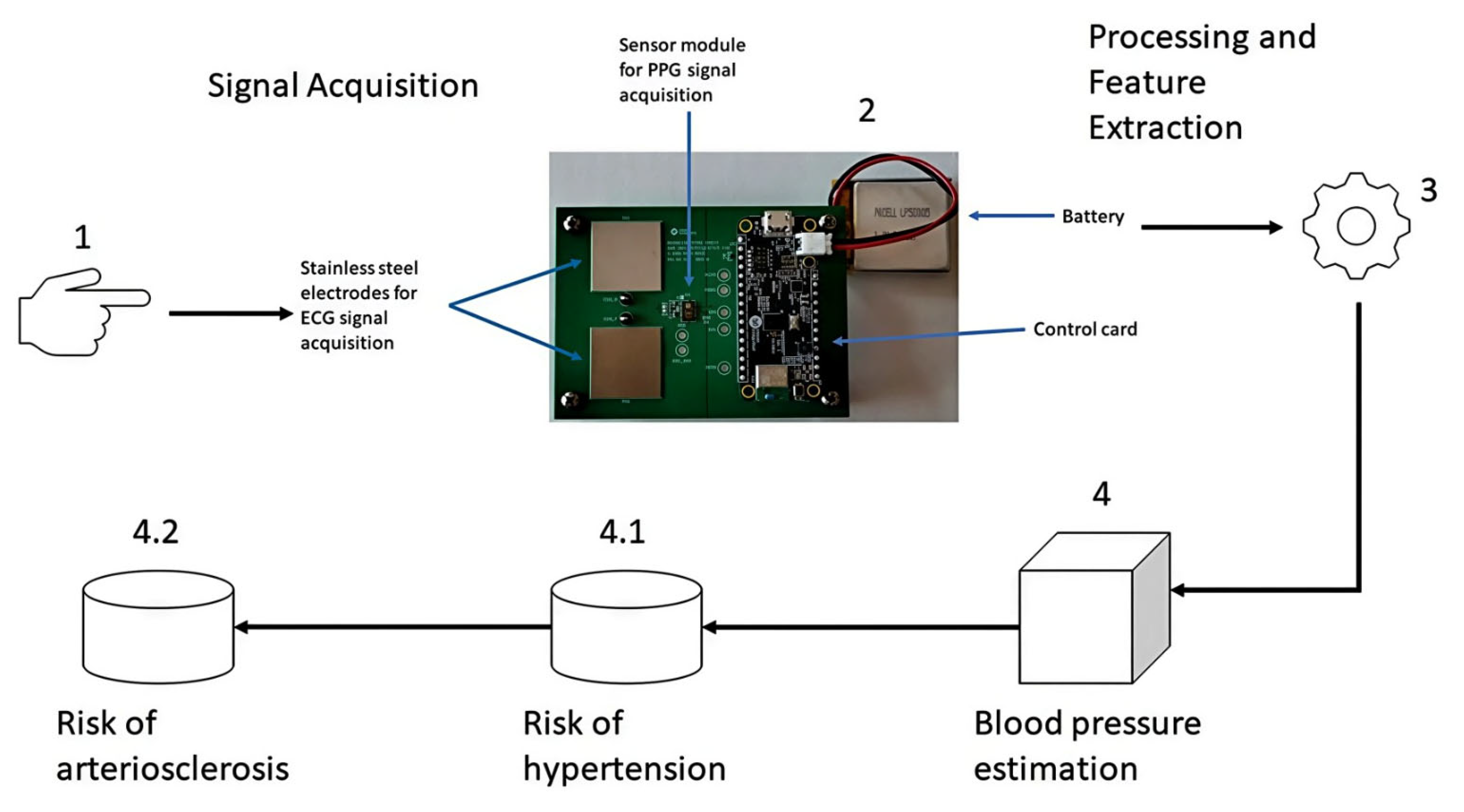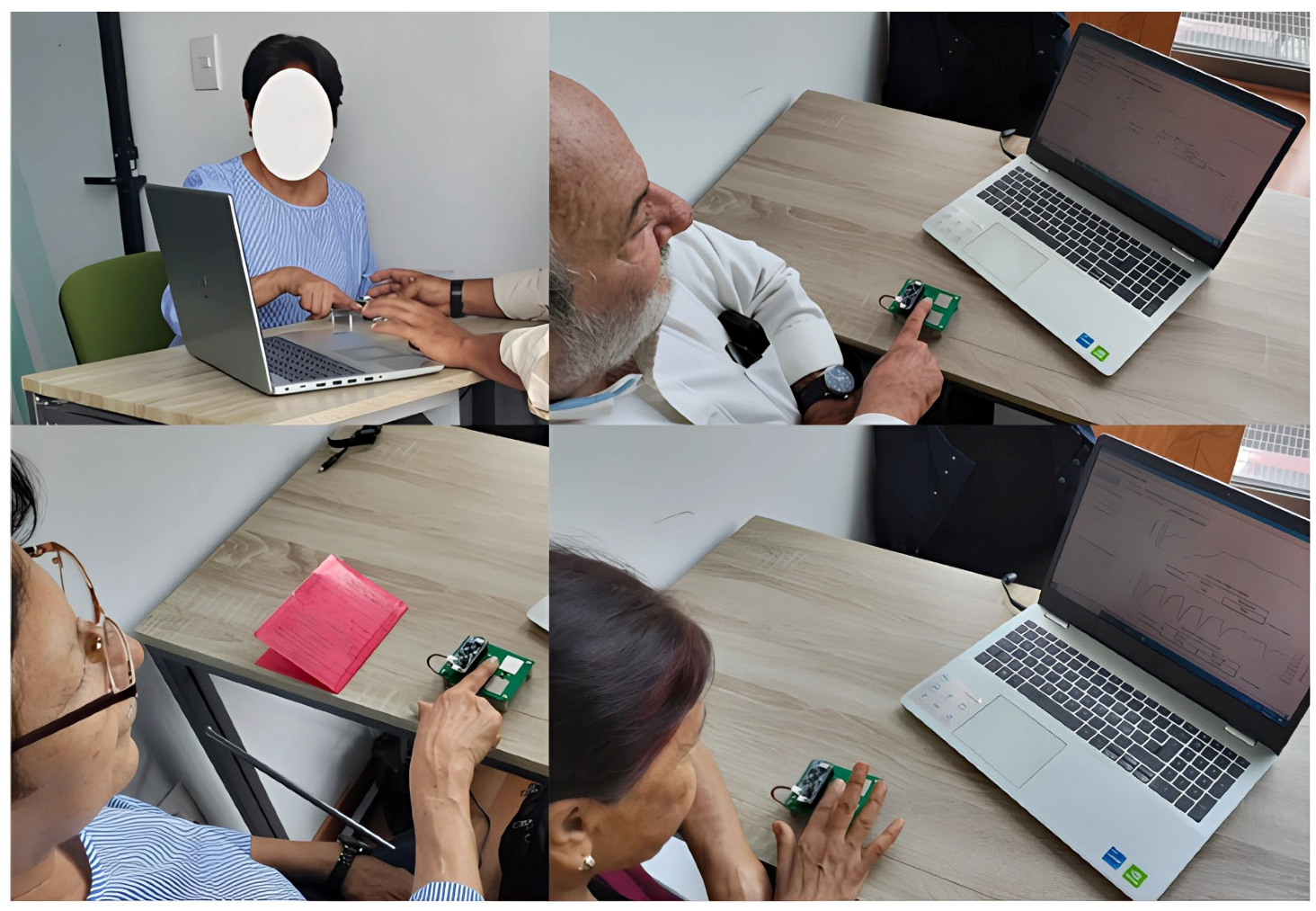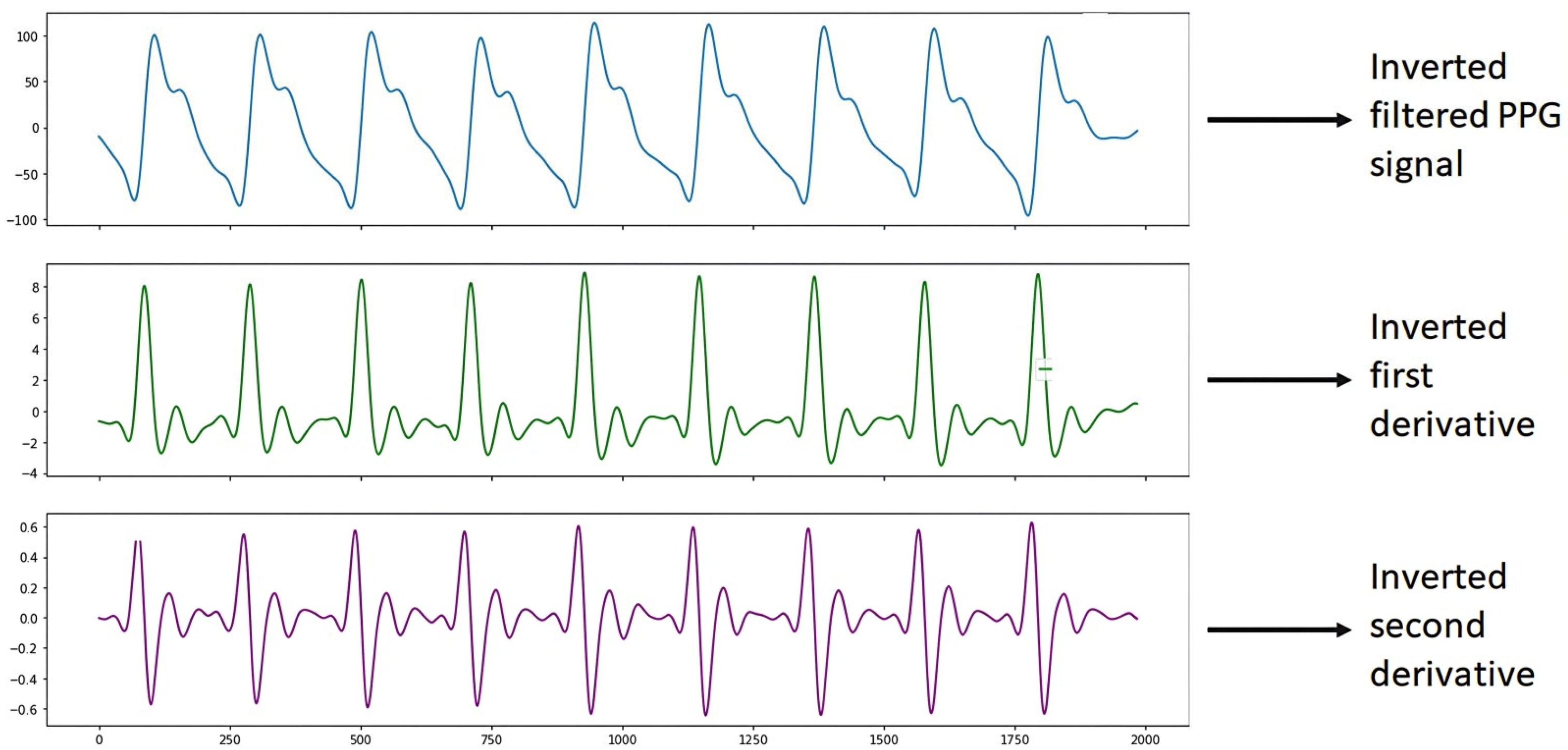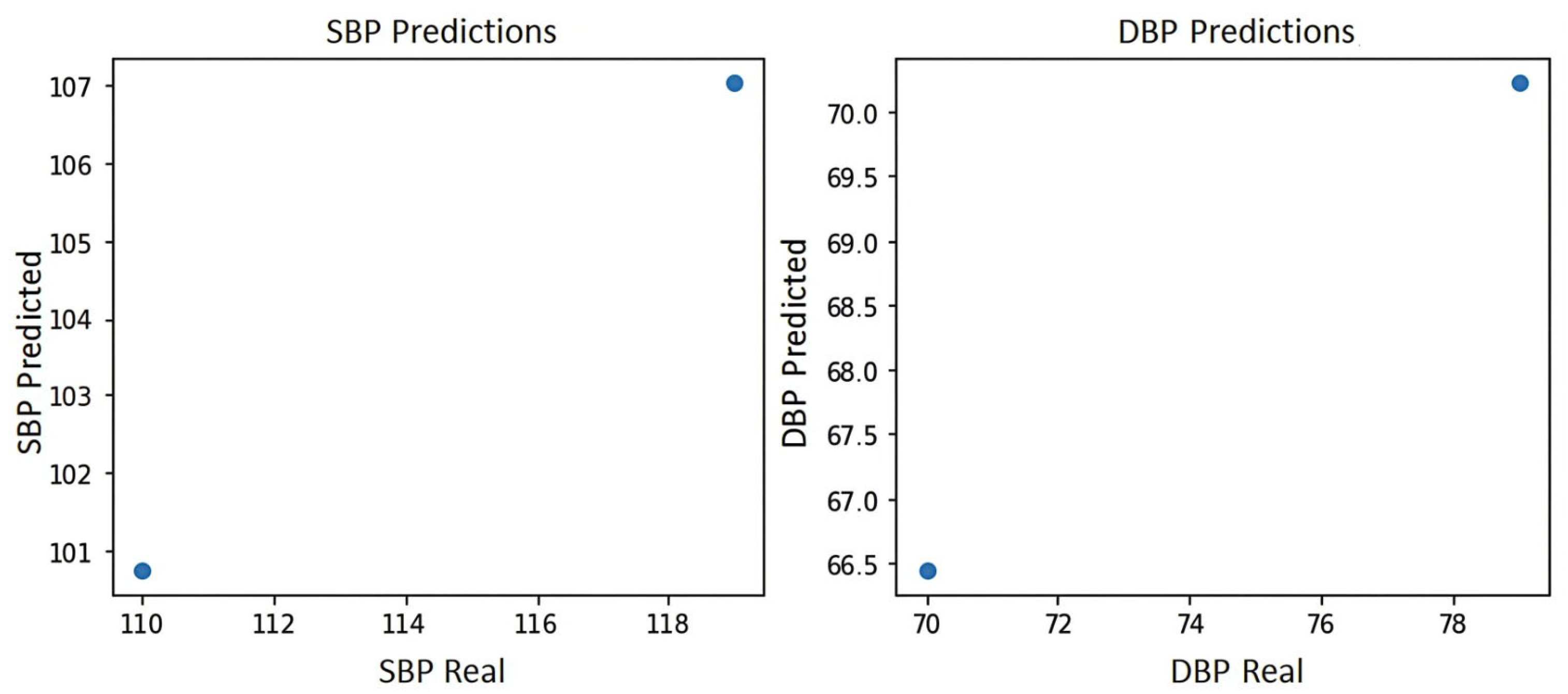Cuff-Less Estimation of Blood Pressure and Detection of Hypertension/Arteriosclerosis from Fingertip PPG Using Machine Learning: An Experimental Study
Featured Application
Abstract
1. Introduction
- (1)
- The use of photoplethysmographic signals and machine learning algorithms to identify risk factors for hypertension and their correlation with arteriosclerosis.
- (2)
- The development of a tool to support physicians in making decisions related to the diagnosis of cardiovascular diseases.
- (3)
- This tool contributes to self-management of health in patients suffering from cardiovascular diseases.
2. Related Works
2.1. Regression
2.2. Classification
3. Materials and Methods
Methodology
4. Results and Discussion
- Instrumentation amplifier to eliminate input noise;
- Adaptive filter acting on the time domain;
- Notch filter to set the operating frequency;
- Low-pass filter to let the desired signal frequencies pass;
- Automatic gain control function to dynamically adjust the current of the red and infrared LEDs of the PPG sensor;
- Function to cancel ambient light;
- Proximity function to detect the position of the finger on the PPG sensor, to mention just a few of the functions of the Max86150 card.
- The Max86150 cardiac signal acquisition card provides us with PPG signals with the least possible noise.
- Although our system has its limitations, our Python 3.10 code for PPG signal processing, although capable of detecting the systolic peak, still requires improvements so that the system does not confuse the diastolic notch with the diastolic peak.
4.1. Healthy Patient (S2)
- Instrumentation amplifier for eliminating input noise;
- Adaptive filter acting on the time domain;
- Notch filter to set the operating frequency;
- Low-pass filter to allow the desired frequencies of the signal to pass through;
- There is an automatic gain control function to dynamically adjust the current of the red and infrared LEDs of the PPG sensor;
- There is a function to cancel ambient light;
- It has a proximity function to detect the position of the finger on the PPG sensor, to mention just a few of the functions of the Max86150 card;
- Our Python code for PPG signal processing.
4.2. Diabetic Patient (S4)
4.3. Hypertensive and Diabetic Patient (S14)
4.4. Findings, Challenges, and Limitations
5. Conclusions and Future Work
Author Contributions
Funding
Institutional Review Board Statement
Informed Consent Statement
Data Availability Statement
Acknowledgments
Conflicts of Interest
Appendix A
| Comparison of Regression Algorithm Performance | |||||||||||
| Metrics | |||||||||||
| Algorithms | MSE | r2 | MAE | RMSE | RMSE_CV | ||||||
| SBP | DBP | SBP | DBP | SBP | DBP | SBP | DBP | SBP | DBP | ||
| 1 | RL | 27.40 | 4.64 | −0.35 | 0.77 | 3.88 | 2.13 | 5.23 | 2.15 | 9.27 | 4.23 |
| 2 | KNN_w_uniform | 164.25 | 69.25 | −7.11 | −2.41 | 12 | 7 | 12.81 | 8.32 | 15.07 | 9.29 |
| 3 | KNN_w_distance | 57.91 | 22.67 | −1.85 | −0.11 | 7.60 | 4.36 | 7.61 | 4.76 | 12.04 | 7.10 |
| 4 | SVR_rbf | 153.13 | 61.57 | −6.56 | −2.04 | 11.65 | 6.65 | 12.37 | 7.84 | 14.84 | 9.04 |
| 5 | SVR_poly | 170.33 | 36.42 | −7.41 | −0.79 | 12.34 | 5.55 | 13.05 | 6.03 | 13.52 | 6.48 |
| 6 | DT | 208 | 58 | −9.27 | −1.86 | 12 | 7 | 14.42 | 7.61 | 14.42 | 7.61 |
| 7 | AdaBoost | 20.5 | 20.5 | −0.01 | −0.01 | 4.5 | 4.5 | 4.52 | 4.52 | 9.47 | 6.07 |
| 8 | GradientBoosting | 61.94 | 16.95 | −2.05 | 0.16 | 7.19 | 4.11 | 7.87 | 4.11 | 11.14 | 5.86 |
| 9 | RandomForest | 67.62 | 31.70 | −2.33 | −0.56 | 7.75 | 4.45 | 8.22 | 5.63 | 11.90 | 7.09 |
| 10 | Bagging_RL | 68.70 | 26.75 | −2.39 | −0.32 | 8.28 | 4.76 | 8.28 | 5.17 | 11.68 | 6.59 |
| 11 | Bagging_SVR_rbf | 170.47 | 69.38 | −7.41 | −2.42 | 12.32 | 7.12 | 13.05 | 8.32 | 15.12 | 9.22 |
| 12 | Bagging_SVR_poly | 115.03 | 22.31 | −4.68 | −0.10 | 9.75 | 4.00 | 10.72 | 4.72 | 13.15 | 6.62 |
| 13 | Bagging_KNN_w_uniform | 176.5 | 73.54 | −7.71 | −2.63 | 12.5 | 7.3 | 13.28 | 8.57 | 15.24 | 9.35 |
| 14 | Bagging_KNN_w_distance | 109.43 | 45.08 | −4.40 | −1.22 | 10.21 | 5.92 | 10.46 | 6.71 | 13.59 | 8.19 |
| 15 | Bagging_DT | 67.62 | 31.70 | −2.33 | −0.56 | 7.75 | 4.45 | 8.22 | 5.63 | 11.90 | 7.09 |
| Morphological Features of the PPG Signal | ||
| Time Domain | Frequency Domain | Statistical Features |
| RR mean (Average RR interval) | VLF Power (Power in the very low frequency band) | Mean (PPG signal average) |
| RR std (Standard deviation of RR intervals) | LF Power (Power in the low frequency band) | Std (Standard deviation of the PPG signal) |
| HR mean (Average heart rate) | HF Power (High frequency band power) | Skewness (PPG signal asymmetry) |
| HR std (Standard deviation of heart rate) | Total Power (Total sum of spectral power in the range of interest) | Kurtosis (Kurtosis of the PPG signal) |
| HRV RMSSD (Square root of the mean of the successive differences squared) | LF/HF Ratio (Relationship between LF and HF powers) | Max (Maximum PPG signal value) |
| VLF (%) (Percentage of power in the VLF band relative to the total) | Min (Minimum PPG signal value) | |
| LF (%) (Porcentaje de potencia en la banda LF respecto al total) | Range (Rango (máx − mín) de la señal PPG) | |
| HF (%) (Porcentaje de potencia en la banda HF respecto al total) | Energy (Energía total de la señal PPG) | |
| Baseline Data of Study Subjects | |||
| Subject | Gender | Age | Cardiovascular Diseases |
| S1 | Male | 72 | Diabetes |
| S2 | Male | 43 | Healthy |
| S3 | Male | 29 | Healthy |
| S4 | Male | 48 | Diabetes |
| S5 | Male | 27 | Hypertension |
| S6 | Male | 42 | Healthy |
| S7 | Male | 42 | Healthy |
| S8 | Feminine | 66 | Healthy |
| S9 | Male | 27 | Healthy |
| S10 | Male | 27 | Healthy |
| S11 | Feminine | 73 | Healthy |
| S12 | Male | 73 | Diabetes |
| S13 | Feminine | 63 | Hypertension and type 2 diabetes mellitus |
| S14 | Male | 69 | Hypertension and diabetes |
| S15 | Feminine | 41 | Hypertension and diabetes |
| S16 | Feminine | 62 | Healthy |
| S17 | Feminine | 67 | Hypertension and diabetes |
| S18 | Feminine | 72 | Hypertension |
| S19 | Male | 64 | Hypertension |
| S20 | Feminine | 66 | Hypertension |
| S21 | Male | 61 | Hypertension |
| S22 | Feminine | 75 | Healthy |
| S23 | Feminine | 61 | Healthy |
| S24 | Male | 63 | Hypertension and diabetes |
| S25 | Male | 52 | Healthy |
| S26 | Feminine | 35 | Healthy |
| S27 | Feminine | 62 | Hypertension and diabetes |
| S28 | Feminine | 48 | Hypertension |
| S29 | Male | 37 | Healthy |
| S30 | Feminine | 60 | Healthy |
| S31 | Feminine | 51 | Hypertension |
| S32 | Male | 61 | Hypertension and diabetes |
| S33 | Male | 54 | Healthy |
| S34 | Male | 75 | Hypertension and diabetes |
| S35 | Feminine | 54 | Healthy |
| S36 | Male | 71 | Healthy |
| S37 | Male | 74 | Healthy |
| S38 | Male | 66 | Healthy |
| S39 | Male | 51 | Diabetes |
| S40 | Male | 72 | Hypertension |
| S41 | Male | 55 | Hypertension |
| S42 | Male | 67 | Healthy |
| S43 | Feminine | 68 | Hypertension and diabetes |
| S44 | Male | 48 | Diabetes |
| S45 | Feminine | 46 | Healthy |
| S46 | Male | 72 | Diabetes |
| S47 | Feminine | 26 | Healthy |
| S48 | Male | 42 | Healthy |
| S49 | Feminine | 35 | Healthy |
| S50 | Feminine | 80 | Healthy |
| S51 | Feminine | 61 | Healthy |
| S52 | Male | 73 | Healthy |
| S53 | Feminine | 45 | Healthy |
| S54 | Feminine | 43 | Healthy |
| S55 | Feminine | 68 | Healthy |
| S56 | Feminine | 66 | Diabetes |
| S57 | Feminine | 28 | Healthy |
| S58 | Feminine | 60 | Hypertension and diabetes |
| S59 | Feminine | 38 | Healthy |
| S60 | Male | 65 | Healthy |
| S61 | Feminine | 58 | Healthy |
| S62 | Feminine | 74 | Healthy |
| S63 | Feminine | 53 | Healthy |
| S64 | Male | 68 | Diabetes |
| S65 | Feminine | 57 | Healthy |
| S66 | Male | 57 | Healthy |
| S67 | Male | 64 | Healthy |
| S68 | Male | 71 | Hypertension and diabetes |
| S69 | Feminine | 24 | Healthy |
| S70 | Feminine | 50 | Diabetes |
| S71 | Feminine | 24 | Healthy |
| S72 | Male | 44 | Hypertension |
| S73 | Male | 65 | Hypertension |
| S74 | Male | 65 | Diabetes |
| S75 | Male | 82 | Hypertension |
| S76 | Male | 33 | Healthy |
| S77 | Feminine | 63 | Hypertension |
| S78 | Male | 71 | Hypertension and diabetes |
| S79 | Feminine | 70 | Hypertension and diabetes |
| S80 | Feminine | 86 | Healthy |
| S81 | Feminine | 48 | Hypertension |
| S82 | Male | 57 | Hypertension and diabetes |
| S83 | Male | 75 | Healthy |
| S84 | Feminine | 70 | Healthy |
| S85 | Male | 48 | Healthy |
| S86 | Feminine | 42 | Diabetes |
| S87 | Male | 54 | Healthy |
| S88 | Feminine | 70 | Healthy |
| S89 | Feminine | 42 | Diabetes |
| S90 | Feminine | 68 | Hypertension and diabetes |
| S91 | Feminine | 30 | Healthy (anemia) |
| S92 | Male | 66 | Hypertension |
| S93 | Male | 46 | Healthy |
| S94 | Feminine | 68 | Diabetes (kidney failure) |
| S95 | Feminine | 44 | Hypertension |
| S96 | Male | 76 | Healthy |
| S97 | Feminine | 69 | Healthy |
| S98 | Feminine | 44 | Healthy |
| S99 | Feminine | 61 | Diabetes |
| S100 | Feminine | 73 | Hypertension (pacemaker) |
| S101 | Male | 75 | Hypertension and prediabetes |
| S102 | Feminine | 36 | Tachycardia and arrhythmia, hypotension |
| S103 | Feminine | 27 | Healthy |
| S104 | Feminine | 66 | Healthy |
| S105 | Feminine | 51 | Healthy |
| S106 | Feminine | 43 | Anemia |
| S107 | Male | 64 | Hypertension and diabetes |
| S108 | Male | 46 | Healthy |
| S109 | Feminine | 61 | Healthy |
| S110 | Feminine | 41 | Healthy |
References
- Día Mundial de la Hipertensión 2024—OPS/OMS|Organización Panamericana de la Salud. Available online: https://www.paho.org/es/campanas/dia-mundial-hipertension-2024 (accessed on 29 August 2025).
- Cardiovascular Diseases (CVDs). Available online: https://www.who.int/news-room/fact-sheets/detail/cardiovascular-diseases-(cvds) (accessed on 28 August 2025).
- Kaptoge, S.; Pennells, L.; De Bacquer, D.; Cooney, M.T.; Kavousi, M.; Stevens, G.; Riley, L.M.; Savin, S.; Khan, T.; Altay, S. World Health Organization cardiovascular disease risk charts: Revised models to estimate risk in 21 global regions. Lancet Glob. Health 2019, 7, e1332–e1345. [Google Scholar] [CrossRef]
- Campbell, N.R.; Dattani, S.; Bell, A.; Gelfer, M.; Cloutier, L.; Petrella, R.; Lindsay, P.; Leung, A.A.; McLean, D.; Kaczorowski, J. Urgent need to increase the rates of diagnosing, treating and controlling hypertension in older women: A call for action. Can. Pharm. J. Rev. Pharm. Can. 2020, 153, 264–269. [Google Scholar] [CrossRef]
- Slivnick, J.; Lampert, B.C. Hypertension and heart failure. Heart Fail. Clin. 2019, 15, 531–541. [Google Scholar] [CrossRef] [PubMed]
- Mousavi, S.S.; Firouzmand, M.; Charmi, M.; Hemmati, M.; Moghadam, M.; Ghorbani, Y. Blood pressure estimation from appropriate and inappropriate PPG signals using A whole-based method. Biomed. Signal Process. Control 2019, 47, 196–206. [Google Scholar] [CrossRef]
- Mathur, P.; Srivastava, S.; Xu, X.; Mehta, J.L. Artificial intelligence, machine learning, and cardiovascular disease. Clin. Med. Insights Cardiol. 2020, 14, 1179546820927404. [Google Scholar] [CrossRef]
- Poznyak, A.V.; Sadykhov, N.K.; Kartuesov, A.G.; Borisov, E.E.; Melnichenko, A.A.; Grechko, A.V.; Orekhov, A.N. Hypertension as a risk factor for atherosclerosis: Cardiovascular risk assessment. Front. Cardiovasc. Med. 2022, 9, 959285. [Google Scholar] [CrossRef]
- Oh, G.C.; Cho, H.-J. Blood pressure and heart failure. Clin. Hypertens. 2020, 26, 1. [Google Scholar] [CrossRef]
- Tjitra, M.A.; Anju, N.E.; Sudiana, D.; Rizkinia, M. A Wireless Noninvasive Blood Pressure Measurement System Using MAX30102 and Random Forest Regressor for Photoplethysmography Signals. Computers 2024, 13, 125. [Google Scholar] [CrossRef]
- Attivissimo, F.; D’Alessandro, V.I.; De Palma, L.; Lanzolla, A.M.L.; Di Nisio, A. Non-Invasive Blood Pressure Sensing via Machine Learning. Sensors 2023, 23, 8342. [Google Scholar] [CrossRef]
- Tarifi, B.; Fainman, A.; Pantanowitz, A.; Rubin, D.M. A Machine Learning Approach to the Non-Invasive Estimation of Continuous Blood Pressure Using Photoplethysmography. Appl. Sci. 2023, 13, 3955. [Google Scholar] [CrossRef]
- Fleischhauer, V.; Feldheiser, A.; Zaunseder, S. Beat-to-Beat Blood Pressure Estimation by Photoplethysmography and Its Interpretation. Sensors 2022, 22, 7037. [Google Scholar] [CrossRef] [PubMed]
- Yang, S.; Sohn, J.; Lee, S.; Lee, J.; Kim, H.C. Estimation and Validation of Arterial Blood Pressure Using Photoplethysmogram Morphology Features in Conjunction With Pulse Arrival Time in Large Open Databases. IEEE J. Biomed. Health Inform. 2021, 25, 1018–1030. [Google Scholar] [CrossRef] [PubMed]
- Lin, W.-H.; Chen, F.; Geng, Y.; Ji, N.; Fang, P.; Li, G. Towards accurate estimation of cuffless and continuous blood pressure using multi-order derivative and multivariate photoplethysmogram features. Biomed. Signal Process. Control 2021, 63, 102198. [Google Scholar] [CrossRef]
- Evdochim, L.; Dobrescu, D.; Halichidis, S.; Dobrescu, L.; Stanciu, S. Hypertension Detection Based on Photoplethysmography Signal Morphology and Machine Learning Techniques. Appl. Sci. 2022, 12, 8380. [Google Scholar] [CrossRef]
- Yin, S.; Li, G.; Luo, Y.; Lin, L. Cuff-less continuous blood pressure measurement based on multiple types of information fusion. Biomed. Signal Process. Control 2021, 68, 102549. [Google Scholar] [CrossRef]
- Fati, S.M.; Muneer, A.; Akbar, N.A.; Taib, S.M. A Continuous Cuffless Blood Pressure Estimation Using Tree-Based Pipeline Optimization Tool. Symmetry 2021, 13, 686. [Google Scholar] [CrossRef]
- Schrumpf, F.; Frenzel, P.; Aust, C.; Osterhoff, G.; Fuchs, M. Assessment of Non-Invasive Blood Pressure Prediction from PPG and rPPG Signals Using Deep Learning. Sensors 2021, 21, 6022. [Google Scholar] [CrossRef]
- Sun, X.; Zhou, L.; Chang, S.; Liu, Z. Using CNN and HHT to Predict Blood Pressure Level Based on Photoplethysmography and Its Derivatives. Biosensors 2021, 11, 120. [Google Scholar] [CrossRef]
- Almarshad, M.; Islam, M.; Al-Ahmadi, S.; BaHammam, A. Diagnostic Features and Potential Applications of PPG Signal in Healthcare: A Systematic Review. Healthcare 2022, 10, 547. [Google Scholar] [CrossRef]
- Pandey, D.; Niwaria, K.; Chourasia, B. Machine learning algorithms: A review. Int. Res. J. Eng. Technol. 2019, 6, 916–922. [Google Scholar]
- Miller, J.R.; Koren, S.; Sutton, G. Assembly algorithms for next-generation sequencing data. Genomics 2010, 95, 315–327. [Google Scholar] [CrossRef]
- Maqsood, S.; Xu, S.; Springer, M.; Mohawesh, R. A benchmark study of machine learning for analysis of signal feature extraction techniques for blood pressure estimation using photoplethysmography (PPG). IEEE Access 2021, 9, 138817–138833. [Google Scholar] [CrossRef]
- MAX86150 Datasheet and Product Info|Analog Devices. Available online: https://www.analog.com/en/products/max86150.html (accessed on 29 August 2025).
- Esgalhado, F.; Batista, A.; Vassilenko, V.; Russo, S.; Ortigueira, M. Peak detection and HRV feature evaluation on ECG and PPG signals. Symmetry 2022, 14, 1139. [Google Scholar] [CrossRef]
- Thupakula, S.; Nimmala, S.S.R.; Ravula, H.; Chekuri, S.; Padiya, R. Emerging biomarkers for the detection of cardiovascular diseases. Egypt. Heart J. 2022, 74, 77. [Google Scholar] [CrossRef]
- Fundación Oftalmológica. Available online: https://fundacionzurita.com.mx/ (accessed on 2 September 2025).
- AHA Research Grant Funding Opportunities. Available online: https://professional.heart.org/en/research-programs/aha-funding-opportunities (accessed on 29 August 2025).
- Carlini, N.; Ippolito, D.; Lee, K.; Tramèr, F.; Jagielski, M.; Zhang, C. Quantifying Memorization Across Neural Language Models. In Proceedings of the Eleventh International Conference on Learning Representations (ICLR), Kigali, Rwanda, 1–5 May 2023; pp. 1–19. [Google Scholar]
- Dhar, P.; Singh, R.V.; Peng, K.-C.; Wu, Z.; Chellappa, R. Learning Without Memorizing. In Proceedings of the 2019 IEEE/CVF Conference on Computer Vision and Pattern Recognition (CVPR), Long Beach, CA, USA, 15–20 June 2019; pp. 5133–5141. [Google Scholar] [CrossRef]
- Hipertensión. Available online: https://www.who.int/es/news-room/fact-sheets/detail/hypertension (accessed on 29 August 2025).
- Módulo de Biosensores Integrado de PPG y ECG Para Dispositivos Móviles MAX86150. Available online: https://www.digikey.com.mx/es/product-highlight/m/maxim-integrated/max86150-integrated-ppg-and-ecg-biosensor-module (accessed on 29 August 2025).











| Cardiovascular Health | ||||||||
|---|---|---|---|---|---|---|---|---|
| Cardiovascular Diseases | Biomedical Variables | |||||||
| Hypertension | Smoking | Obesity | Diabetes | Cholesterol | Age | Gender | Triglycerides | |
| Arteriosclerosis | >139/89 mmHg | Yes | >30 kg/m2 | ≥200 mg/dL | >200 mg/dL | Yes | Yes | >150 mg/dL |
| Atherosclerosis | ||||||||
| Thoracic aortic disease | ||||||||
| Peripheral vascular disease | ||||||||
| Blood vessel disease | ||||||||
| Metrics | ||||||||
|---|---|---|---|---|---|---|---|---|
| MSE | r2 | RMSE | RMSE (CV) | |||||
| Algorithms | SBP | DBP | SBP | DBP | SBP | DBP | SBP | DBP |
| KNN_w_distance | 114.463695 | 44.8830554 | 4.65252815 | 1.21644718 | 10.6987707 | 6.69948172 | 13.0435943 | 7.52189411 |
| Bagging_LR | 40.4652578 | 6.32281631 | 0.99828434 | 0.68776216 | 6.36123084 | 2.51452109 | 10.501906 | 5.05354269 |
| Metrics | ||||||
|---|---|---|---|---|---|---|
| Algorithms | MSE | r2 | RMSE | CV | Predictions | |
| RMSE | Normal | Elevated | ||||
| KNN_w_distance | 0.14495632 | 0.4201747 | 0.3807313 | 0.41336409 | 0.43 | 0.68 |
| Bagging_LR | 0.09832275 | 0.606709 | 0.31356459 | 0.37501865 | 0.44 | 1 |
| Metrics | ||||||
|---|---|---|---|---|---|---|
| Algorithms | MSE | r2 | RMSE | CV | Predictions | |
| RMSE | None | Low | ||||
| KNN_w_distance | 0.14495632 | 0.4201747 | 0.3807313 | 0.41336409 | 0.43 | 0.68 |
| Bagging_LR | 0.09832275 | 0.606709 | 0.31356459 | 0.37501865 | 0.44 | 1 |
| Metrics | ||||||||
|---|---|---|---|---|---|---|---|---|
| MSE | r2 | RMSE | RMSE (CV) | |||||
| Algorithms | SBP | DBP | SBP | DBP | SBP | DBP | SBP | DBP |
| KNN_w_distance | 114.347872 | 47.9495273 | 4.64680848 | 1.36787789 | 10.6933564 | 6.92455972 | 13.0484241 | 7.66986597 |
| Bagging_LR | 50.0419466 | 5.93115604 | 1.47120724 | 0.70710341 | 7.07403326 | 2.43539649 | 10.9254026 | 5.09284567 |
| Metrics | ||||||
|---|---|---|---|---|---|---|
| Algorithms | MSE | r2 | RMSE | CV | Predictions | |
| RMSE | Normal | Elevated | ||||
| KNN_w_distance | 0.19234829 | 0.23060683 | 0.4385753 | 0.48133115 | 0.64 | |
| Bagging_LR | 0.115845 | 0.53662002 | 0.3403601 | 0.4466637 | 0.48 | 1 |
| Metrics | ||||||
|---|---|---|---|---|---|---|
| Algorithm | MSE | r2 | RMSE | CV | Predictions | |
| RMSE | None | Low | ||||
| KNN_w_distance | 0.19234829 | 0.23060683 | 0.4385753 | 0.48133115 | 0.48 | 0.5 |
| Metrics | ||||||||
|---|---|---|---|---|---|---|---|---|
| MSE | r2 | RMSE | RMSE (CV) | |||||
| Algorithm | SBP | DBP | SBP | DBP | SBP | DBP | SBP | DBP |
| Bagging_LR | 606.113844 | 188.0911 | 28.9315478 | 8.28844937 | 24.6193794 | 13.7146309 | 20.0725919 | 11.1174032 |
| Metrics | ||||||
|---|---|---|---|---|---|---|
| Algorithm | MSE | r2 | RMSE | CV | PREDICTIONS | |
| RMSE | LEVEL 1 | LEVEL 2 | ||||
| Bagging_LR | 0.09298517 | 0.62805933 | 0.30493469 | 0.79458069 | 0.43 | 0.74 |
| Metrics | ||||||
|---|---|---|---|---|---|---|
| Algorithm | MSE | r2 | RMSE | CV | PREDICTIONS | |
| RMSE | HALF | HIGH | ||||
| Bagging_LR | 0.09298517 | 0.62805933 | 0.30493469 | 0.79458069 | 0.43 | 0.74 |
| Blood Pressure | Measure |
|---|---|
| SBP | Average prediction = 103.30 |
| SBP | 95% confidence interval = [90.00, 115.00] |
| DBP | Average prediction = 67.64 |
| DBP | 95% confidence interval = [60.00, 75.00] |
Disclaimer/Publisher’s Note: The statements, opinions and data contained in all publications are solely those of the individual author(s) and contributor(s) and not of MDPI and/or the editor(s). MDPI and/or the editor(s) disclaim responsibility for any injury to people or property resulting from any ideas, methods, instructions or products referred to in the content. |
© 2025 by the authors. Licensee MDPI, Basel, Switzerland. This article is an open access article distributed under the terms and conditions of the Creative Commons Attribution (CC BY) license (https://creativecommons.org/licenses/by/4.0/).
Share and Cite
Arroyo-Ramírez, M.A.; Machorro-Cano, I.; Reyes-Delgado, A.J.; González-Díaz, J.E.; Sánchez-Cervantes, J.L. Cuff-Less Estimation of Blood Pressure and Detection of Hypertension/Arteriosclerosis from Fingertip PPG Using Machine Learning: An Experimental Study. Appl. Sci. 2025, 15, 11829. https://doi.org/10.3390/app152111829
Arroyo-Ramírez MA, Machorro-Cano I, Reyes-Delgado AJ, González-Díaz JE, Sánchez-Cervantes JL. Cuff-Less Estimation of Blood Pressure and Detection of Hypertension/Arteriosclerosis from Fingertip PPG Using Machine Learning: An Experimental Study. Applied Sciences. 2025; 15(21):11829. https://doi.org/10.3390/app152111829
Chicago/Turabian StyleArroyo-Ramírez, Marco Antonio, Isaac Machorro-Cano, Augusto Javier Reyes-Delgado, Jorge Ernesto González-Díaz, and José Luis Sánchez-Cervantes. 2025. "Cuff-Less Estimation of Blood Pressure and Detection of Hypertension/Arteriosclerosis from Fingertip PPG Using Machine Learning: An Experimental Study" Applied Sciences 15, no. 21: 11829. https://doi.org/10.3390/app152111829
APA StyleArroyo-Ramírez, M. A., Machorro-Cano, I., Reyes-Delgado, A. J., González-Díaz, J. E., & Sánchez-Cervantes, J. L. (2025). Cuff-Less Estimation of Blood Pressure and Detection of Hypertension/Arteriosclerosis from Fingertip PPG Using Machine Learning: An Experimental Study. Applied Sciences, 15(21), 11829. https://doi.org/10.3390/app152111829









